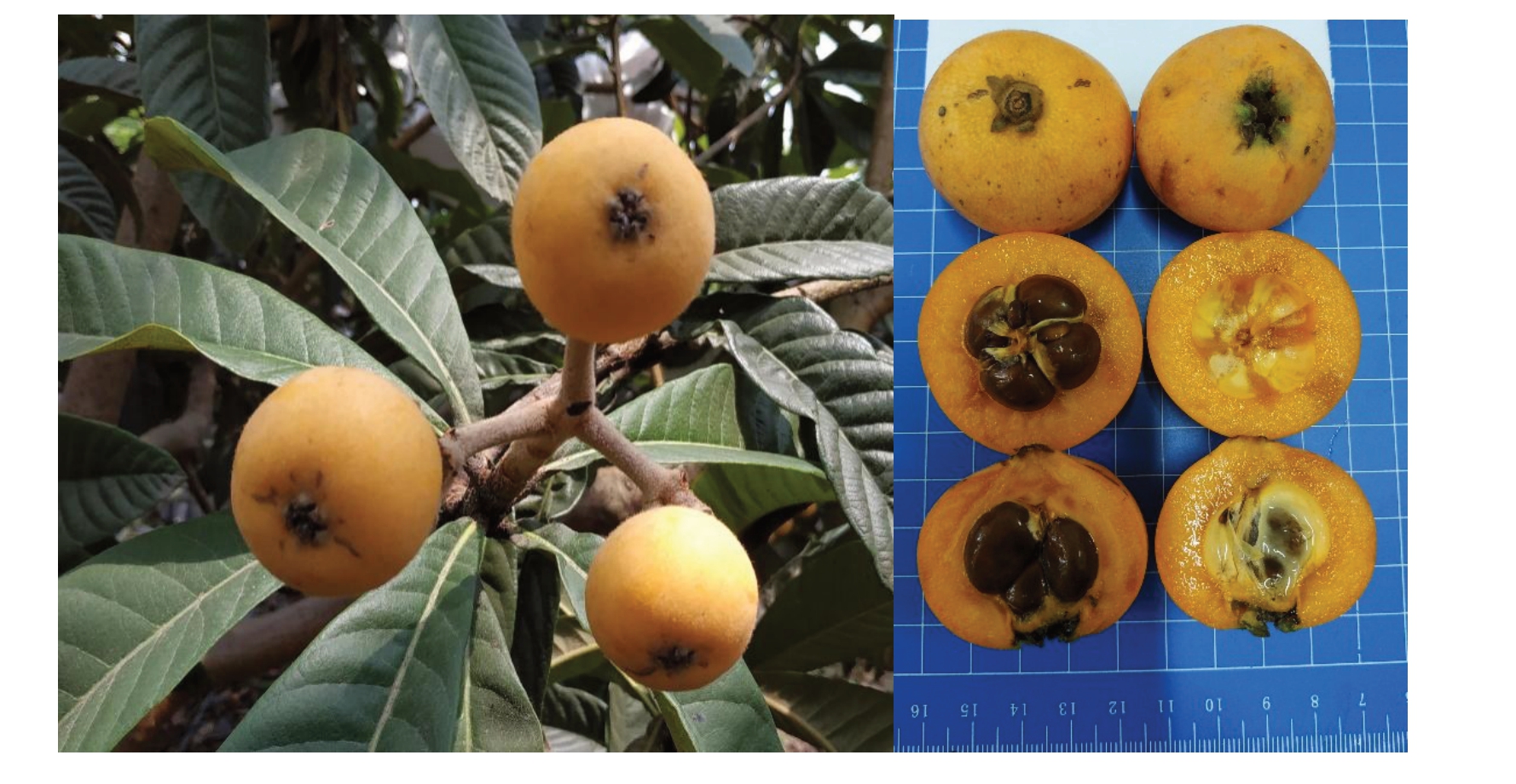枇杷是蔷薇科中较特殊的常绿果树,一般秋萌冬花,春实夏熟,在百果中独具先天四时之气,被誉为独冠时新的佳果珍味[1]。近年来,在科技进步和市场经济的推动下,我国枇杷生产有了长足的发展[2],尤其是以大五星为代表的黄肉枇杷,成为西南枇杷产区的主栽品种。但由于大五星抗叶斑病能力差,树龄老化后果实品质和产量下降趋势明显,严重制约了四川枇杷产业的发展[3]。因此,许多科研单位以大五星为亲本持续开展品种改良工作[4-5]。四川省农业科学院园艺研究所与四川农业大学园艺学院等单位从2001 年开始依托枇杷公益性行业专项和四川省农作物畜禽育种攻关项目,广泛开展了枇杷种质资源的收集、保存与创制工作,历时20 余年选育出优质黄肉枇杷新品种西蜀2号。
1 选育经过
2010年项目组以大五星为母本、贵妃为父本进行杂交组配,次年将获得的杂交种播种于成都市龙泉驿区阳光城四川省农业科学院园艺研究所枇杷示范园,其中单株4-32 于2015 年开始结果,2016 年大量结果,表现为风味佳、纯甜、抗日灼、抗叶斑病的特性,当年确定为优选株系。
该优株于2016年在成都市龙泉驿区阳光城、天府新区永兴街道和新都区泰兴镇开展扩繁试验,2017—2019 年对该品种进行树体生长发育、开花结果习性及果实品质等情况的现场调查与观测,确定其优良性状遗传稳定,符合育种目标。每年该品种果实成熟时,邀请同行果树专家、果树种植专业大户等相关人员进行现场品尝和评价。2019 年5 月18日该品种顺利通过四川省种子站组织的果树新品种田间技术鉴定,2020 年4 月获四川省非主要农作物品种认定委员会证书(川认果2020002),定名为西蜀2号(图1)。

图1 枇杷新品种西蜀2 号
Fig.1 A new loquat cultivar Xishu 2
2 主要性状
2.1 植物学特征
树势中庸偏强,树冠开张。2 年生以上枝条呈棕褐色,茸毛数量较多。叶形为椭圆形,叶尖钝圆,叶基呈楔形;成熟叶片长22.06 cm,宽7.10 cm,厚0.39 mm,叶柄长8.55 mm;中脉正面凸起,侧脉形状弯出,背面网脉明显;叶片正面褶皱,老叶正面光滑,背面有茸毛。花序中等,呈圆锥形,长宽相近,平均13.2 cm,主轴挺直,支轴平伸。花量适中且松散,每花序花朵数量40~100朵,花朵中小,花瓣呈黄白色。
2.2 果实经济性状与生产力表现
果实近圆形,整齐度好,单果质量40~55 g。果顶平广,果点小,果面茸毛短、稀疏;萼片平展、萼孔开张。果皮和果肉均呈黄色,且易剥皮;果肉细嫩化渣,汁液多,风味浓甜,可溶性固形物含量(w)15.30%,品质佳。种子数2~5 粒,平均可食率71.6%(表1)。
表1 西蜀2 号与对照品种比较试验结果(龙泉驿区阳光城,2017—2019 年)
Table 1 Comparative test results of Xishu 2 and the check variety(Sunny city,Longquanyi district,2017 to 2019)

品种Cultivar西蜀2号Xishu 2大五星Dawuxing贵妃Guifei平均单果质量Average fruit weight/g 46.80 56.40 37.31 w(可溶性固形物)soluble solid content/%15.30 12.58 15.56 w(总糖)Total sugar content/%13.24 10.36 14.20 w(总酸)Total acid content/%0.45 0.39 0.79 w(维生素C)Vitamin C content/(mg·kg-1)4.67 7.14 4.52可食率Edible rate/%71.50 72.20 66.67叶斑病病情指数Disease index of leaf spot disease 1.08 10.28 6.25
生产试验表明,西蜀2号(4-32)嫁接成活率高,自花结实能力强,坐果率高,丰产性好。成都地区1年生嫁接苗定植后第3 年成花和坐果株率超过30%,第4年成花和坐果株率达100%;春季高接换种后次年成花率可达100%,第3年可恢复2.5 m×2.0 m以上冠幅,平均每株产量达22.25 kg。与四川省主栽黄肉枇杷品种大五星相比,西蜀2 号的可溶性固形物含量、总糖含量、总酸含量均有明显提升;与白肉枇杷亲本贵妃相比,西蜀2 号的单果质量和可食率有明显提升。
2.3 物候期
西蜀2号在成都地区每年抽发3次梢,以晚春梢和早夏梢结果为主,春梢大量抽发期为2月中旬至3月下旬,夏梢大量抽发期为5月下旬至6月中旬,秋梢大量抽发期为8月中旬至9月初。每年6—7月进入花芽分化期,9—10月抽生花序,11月中下旬进入盛花期,12月底终花。果实成熟期为5月上中旬,果实全生育期160 d左右。
2.4 抗逆性与适应性
西蜀2 号适应性强,果皮厚,不易裂果、抗日灼。多年多点连续观测结果表明,西蜀2 号叶斑病病情指数平均为1.08,抗叶斑病能力明显强于其亲本和四川省其他主推枇杷品种。
3 栽培技术要点
3.1 定植前处理
栽植时期以秋季9 月中旬—10 月上旬和春季2月上旬—3 月上旬定植为宜,秋植最佳。栽植密度以株行距(3~4)m×(4~5)m 为宜。带土球苗木在起苗前3~5 d 用广谱性杀菌剂喷雾叶片。起苗时剪去每片叶1/2~1/3 的叶面积,减少水分蒸发。栽植前,解除嫁接膜,剪掉残枝、断枝。在定植点上挖比苗木根幅稍大的定植穴,将苗木轻轻放入定植穴,扶正苗木,用熟化的表层细土作为定植土,填土后踏实。定植完毕后做直径≥80 cm 水圈,浇足定根水,用细土覆盖露出的根系后进行垄面覆盖或树盘覆盖,覆盖物可选用地布或厚度≥0.03 mm的地膜。
3.2 肥水管理
幼树遵循勤施薄施原则,前期以氮肥为主,每次每株100 g左右,后期增加磷钾肥比例,促进花芽分化。成年树花前肥,占全年施肥量的50%~60%。在8 月下旬至9 月上旬施入。每株施20~30 kg 腐熟有机肥+1.0~1.5 kg 均衡型复合肥,可在此次肥中加入1.5%的硼砂微肥。壮果肥占全年施肥量的20%~25%。在3 月下旬至4 月上旬施入。每株施150~200 g 高钾型水溶肥或300~400 g 颗粒复合肥,可适量加入铁、锌、钙肥。采果肥占全年施肥量的20%~30%。在采果后至夏梢抽发前施入。每株施200~300 g均衡型水溶肥或500~600 g颗粒复合肥。
3.3 整形修剪
该品种宜采用双层杯状形树形,具有缓和树势、提升产量、易管理等优点。幼年树以采取抹嫩梢的方法为主,抹去多余的新梢,选留方向、位置适宜的梢。成年结果树通过疏梢减少枝梢数,使结果枝组充实健壮,保持全树营养枝与结果枝的比例为2∶(3~4)。
3.4 花果管理
在9月底—10月上旬能看清全树花序且花序支轴尚未分离前进行疏花。主要疏除衰弱枝和长结果母枝上的花序、小花序、病虫花序和过多的花,选留顶生的短结果母枝上的花序。在2月份冻害结束后进行疏果。先疏除畸形果、病虫果、伤果及受冻果,再疏去较小的和多余的幼果,每穗留3~6个果。
4 应用推广前景
西蜀2 号是中熟黄肉枇杷新品种,其特点是风味浓甜,果皮厚,不易裂果,抗日灼、抗叶斑病,且自花结实能力强,丰产性好。该品种与大五星互相授粉效果好,是一个具有发展潜力的新品种,适宜在四川盆地和盆周中低海拔山区推广。
[1] 蔡礼鸿.枇杷学[M].北京:中国农业出版社,2012:1-2.CAI Lihong.Loquat science [M].Beijing: China Agricultural Press,2012:1-2.
[2] 蒋际谋,陈秀萍,邓朝军,许奇志,郑少泉.我国枇杷产业优劣势分析与发展对策[J].中国园艺文摘,2018,34(4):46-48.JIANG Jimou,CHEN Xiuping,DENG Chaojun,XU Qizhi,ZHENG Shaoquan.Analysis on the advantages and disadvantages of loquat industry in China and development countermeasures[J].Chinese Horticultural Abstracts,2018,34(4):46-48.
[3] 江国良,陈栋,孙淑霞,李靖,涂美艳.四川枇杷产业存在的问题与发展建议[C]//第七届全国枇杷学术研讨会论文集.北京:中国园艺学会,2015:240-242.JIANG Guoliang,CHEN Dong,SUN Shuxia,LI Jing,TU Meiyan.Problems and development suggestions of loquat industry in Sichuan province [C]//Selected papers of the 7th National Symposium on Coquat.Beijing:Chinese Society of Horticulture,2015:240-242.
[4] 杨勇胜,李庆宏,江旭升,魏椿,邓勇,陈树红,曾庆华.枇杷新品种黔光2 号的选育[J].果树学报,2021,38(10):1817-1820.YANG Yongsheng,LI Qinghong,JIANG Xusheng,WEI Chun,DENG Yong,CHEN Shuhong,ZENG Qinghua.Breeding of a new loquat cultivar Qianguang 2 [J].Journal of Fruit Science,2021,38(10):1817-1820.
[5] 杨志武,邓群仙,王永清,杜奎,潘翠萍,张卉,张慧芬,王羊.春季开花的枇杷新品种‘春花1 号’[J].园艺学报,2021,48(S2):2819-2820.YANG Zhiwu,DENG Qunxian,WANG Yongqing,DU Kui,PAN Cuiping,ZHANG Hui,ZHANG Huifen,WANG Yang.A new spring flowering loquat cultivar‘Chunhua 1’[J].Acta Horticulturae Sinica,2021,48(S2):2819-2820.